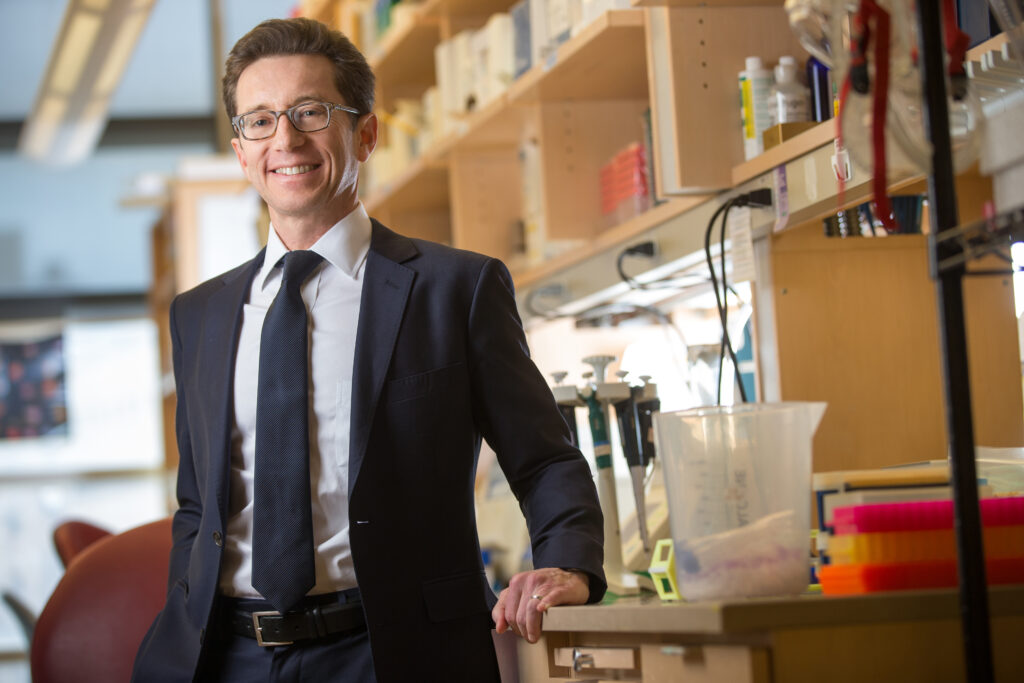Electrochemistry innovator and pioneering physician join 20 others from CWRU who have been appointed during past decade
Robert Savinell and Jonathan Stamler will join a prestigious group of researchers and innovators from Case Western Reserve University as the newest elected Fellows of the National Academy of Inventors (NAI). The honor highlights the overall careers and impacts individual inventors have had in society and their respective fields.
Savinell, a Distinguished University Professor and the George S. Dively Professor of Engineering, is an internationally recognized scholar in the field of electrochemistry and a foundational leader for CWRU’s electrochemical community. His 40-year career includes groundbreaking work in energy conversion and storage.
Stamler, the Robert S. and Sylvia K. Reitman Family Foundation Distinguished Professor of Cardiovascular Innovation, is a professor of medicine and biochemistry. He is also the founding director of the medical school’s Institute for Transformative Molecular Medicine and co-founder and president of the Harrington Discovery Institute at University Hospitals Health System.
Stamler also is an internationally acclaimed physician scientist for the discovery of protein S-nitrosylation, microscopic markers on proteins that play a role in the body’s normal function.
“This year’s class of NAI Fellows showcases the caliber of researchers that are found within the innovation ecosystem,” said NAI President Paul R. Sanberg. “(These) individuals are making significant contributions to both science and society through their work. This new class, in conjunction with our existing Fellows, are creating innovations that are driving crucial advancements across a variety of disciplines and are stimulating the global and national economy in immeasurable ways as they move these technologies from lab to marketplace.”
Leader in electrochemistry field
In a sense, Savinell’s career has been guided by a poster he spotted on a colleague’s office door after joining Case Western Reserve in 1986.
“The sign had to do with understanding fundamentals and then doing something new with them,” Savinell said. “It’s about creativity and ultimately action. I always took that challenge to heart.”

A former director of the Ernest B. Yeager Center for Electrochemical Sciences and dean of engineering at CWRU, Savinell is renowned for his contributions to fundamental electrochemical engineering and science.
His recent achievements include leading efforts to establish the university’s Breakthrough Center for Electrolyte Energy Storage, which since 2018 has secured nearly $23 million in support from the U.S. Department of Energy. Last year Savinell also received the prestigious Vittorio De Nora Award from the Electrochemical Society.
Savinell is proud of his inventions—like a high-temperature proton-conducting polymer for fuel cells and technologically advanced low-cost batteries primarily using water, salt, and iron. Even more meaningful are their current real-world applications.
“As engineers we understand technical problems, so we try to come up with solutions,” he said, noting his gratitude to his colleagues for the nomination. “It is especially exciting to me that the NAI honor recognizes invention and innovation in the academic community, and I feel fortunate here at CWRU because our university values it as well.”
‘Outlier,’ innovator at the School of Medicine
The NAI is celebrating Stamler for “his groundbreaking work” in discovering protein S-nitrosylation. But in his prolific career, Stamler is also known for innovation and entrepreneurship: He has founded nine biotechnology companies, as well as institutes, medical societies, innovation platforms and impact investment funds. Stamler also has co-authored nearly 400 original manuscripts and contributed to 225 patents. In addition, companies he co-founded have developed two drugs approved by the U.S. Food and Drug Administration, as well as medical and wearable devices.

Stamler’s transformative work—from redefining the human respiratory cycle to unraveling microbiome signaling—has earned him several major awards as well as features in esteemed publications. It also has left an indelible mark in the field of nitric oxide/redox biology—and biological sciences at-large.
“I’ve always believed that ideas—which really represent creativity at its core—can have significant impacts on human health,” said Stamler, who joined CWRU in 2010.
He was recently described by a study, conducted by New York University’s Stern School of Business, as an “outlier innovator” for innovation with “no adjacencies.” The NAI honor is further validation of his achievements, he said.
“I feel grateful and honored to even be nominated,” Stamler said. “I appreciate the recognition—particularly for the emphasis on the importance of innovation. As scientists, discovery and creativity is an important part of who we are. It’s nice to see that recognized.”
Learn more about CWRU’s NAI Fellows.
For more information, contact Colin McEwen at colin.mcewen@case.edu.


